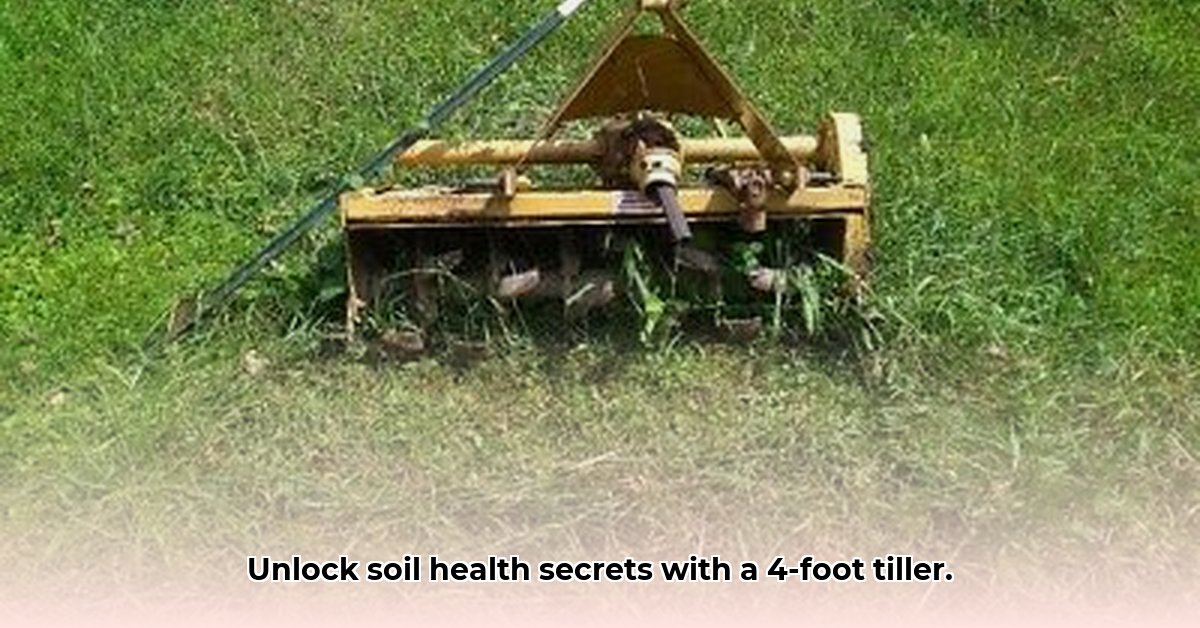
4-Foot Tractor Tiller: Your Guide to Healthier Soil
This guide explores how a 4-foot tractor tiller can contribute to sustainable and productive farming practices. It's crucial to understand that tilling is not simply about churning up dirt; it's about strategically managing your soil ecosystem for optimal crop health and environmental responsibility. Effective utilization requires a nuanced approach tailored to your specific soil type and agricultural goals. For more information on rotary tillers, check out this helpful resource.
Understanding Your Soil: The Foundation of Your Harvest
Before you begin tilling, thoroughly assess your soil type. Is it heavy clay (dense and prone to compaction), loose sand (poor water retention), or the ideal loam (a balanced mix)? Soil type dictates the appropriate tilling technique and frequency. For instance, heavy clay soils benefit from minimal tilling to avoid further compaction, while sandy soils might require more frequent, shallower tillage to retain moisture.
Consider your soil a vibrant ecosystem teeming with beneficial microorganisms, fungi, and earthworms. Excessive tilling disrupts this intricate system, leading to erosion (loss of valuable topsoil), reduced water retention, and a decline in soil health. Therefore, a balanced and mindful approach is paramount.
Tilling Smart: Optimizing Tillage for Soil Health
A 4-foot tractor tiller offers significant power, but its responsible use is vital for long-term sustainability. Over-tilling is a common mistake, causing more harm than good. Deep tillage, typically conducted less frequently, improves soil aeration. Shallow tillage, more common, ensures consistent seedbed preparation.
Here's a step-by-step approach to effective and responsible tilling:
Assess Soil and Crop Needs: Determine your soil's characteristics and the specific demands of your chosen crops. This dictates tilling depth and frequency.
Clear the Field: Remove large rocks, debris, and sticks to prevent tiller damage and ensure even tilling.
Set the Tiller Depth: This setting is crucial. Excessive depth can damage soil structure, while insufficient depth provides inadequate results. Refer to your tiller's manual for guidance, adjusting settings based on your soil type.
Maintain a Steady Pace: Multiple passes are advisable, especially on heavier soils. This gradual approach minimizes compaction and ensures thorough mixing.
Continuous Monitoring: Regularly observe your soil's condition to assess the tilling effectiveness and adjust your technique as needed. Experience is key to mastering this skill.
Beyond the Tiller: Diversifying Soil Health Practices
While a 4-foot tractor tiller serves a valuable purpose, it shouldn't be your sole strategy for soil improvement. Consider sustainable alternatives such as no-till farming (which minimizes soil disturbance, thereby preserving soil structure and minimizing erosion) and cover cropping (planting specific crops to enhance soil health). These methods, alongside responsible tilling, create a comprehensive approach to soil health management.
Weighing the Pros and Cons of Tilling: A Balanced Perspective
It's important to recognize both the advantages and disadvantages of tilling:
| Advantages | Disadvantages |
|---|---|
| Efficient seedbed preparation | Potential for soil damage with overuse |
| Effective weed control | Contributes to erosion if not managed carefully |
| Incorporates organic matter into the soil | High energy consumption |
| Relatively affordable compared to other options | Can compact soil if used incorrectly |
Remember, sustainable farming is an iterative process. A 4-foot tractor tiller is a valuable tool, but it's essential to utilize it judiciously and explore other techniques to optimize soil health and long-term productivity.
Minimizing Soil Compaction: A No-Till Farming Approach
Soil compaction significantly reduces crop yields. Heavy machinery and wet conditions exacerbate this issue. However, preventative measures often prove more effective than reactive fixes.
Understanding Soil Compaction: The Root of the Problem
Compacted soil impedes root growth, water penetration, and air circulation. This leads to stunted plants, reduced yields, and ultimately, diminished profitability. Deep tillage, often touted as a solution, provides only inconsistent results and potentially worsens the problem.
Preventative Measures: Proactive Soil Management
Preventing compaction is key:
Optimal Tire Pressure: Correct tire inflation distributes weight evenly, reducing pressure on the soil. Over-inflation concentrates pressure, while under-inflation causes slippage and compaction. Regularly check and adjust based on soil conditions.
Avoid Tilling Wet Soils: Working wet soil creates severe compaction. Plan operations to avoid soggy conditions. A short delay can prevent significant long-term damage.
Reduce Axle Loads: Consider lighter equipment or alternative tillage methods to lessen soil pressure. Spreading loads across multiple axles can also help significantly. This is particularly relevant when managing large, severely compacted fields.
Strategic Crop Rotation: Rotating crops with varying root depths improves soil structure. Deep-rooted plants help break up compacted layers, creating a healthier soil profile over time.
Cover Cropping: Planting cover crops acts as a natural soil conditioner. Their roots loosen compacted soil, improving structure, water infiltration, and reducing erosion risks overall.
The Role of Your 4-Foot Tiller in a No-Till System
While a 4-foot tractor tiller can be part of a no-till strategy, its use should be minimal and targeted (e.g., for specific planting rows), minimizing disruption to the overall soil structure. Precision planting techniques with specialized no-till equipment are often preferred.
Pivotal Points for Sustainable Tillage:
- Prioritize preventative measures over reactive fixes.
- Maintain optimal tire inflation for weight distribution.
- Avoid working soil when wet to prevent compaction.
- Employ lighter equipment or distribute loads across axles.
- Rotate crops strategically to improve soil structure.
- Incorporate cover cropping practices for soil health.